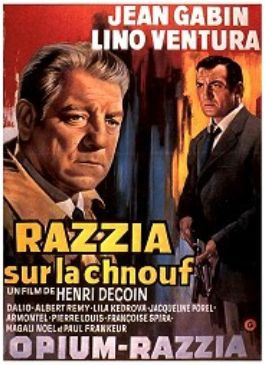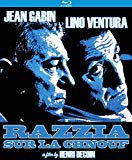| Reviews & Columns |
|
Reviews DVD TV on DVD Blu-ray 4K UHD International DVDs In Theaters Reviews by Studio Video Games Features Collector Series DVDs Easter Egg Database Interviews DVD Talk Radio Feature Articles Columns Anime Talk DVD Savant Horror DVDs The M.O.D. Squad Art House HD Talk Silent DVD
|
DVD Talk Forum |
|
|
| Resources |
|
DVD Price Search Customer Service #'s RCE Info Links |
|
Columns
|
|
|
Razzia sur la chnouf
The film is not at all a rehash. Rather, it's more of an exposé of France's drug trade, a bit less original but slickly made and, for its time, quite explicit. What's most interesting about the picture is how it depicts the strict hierarchy of gangsters and pushers, and how it's managed much like any other business - in this anticipating elements so strong in Francis Coppola's later The Godfather (1972). Also, in Razzia a third-act character is a desperate, pitiful addict played by Lila Kedrova, whose character clings to Gabin as if he were a lifeline. Alfred Hitchcock had to have seen it; in his Torn Curtain (1966), Kedrova plays virtually the same character, only this time an exiled countess desperate to flee East Germany.
After many years in the Americas, master criminal Henri Ferre (Gabin), alias "le Nantais," returns to France, recruited by illegal narcotics boss Paul Liski (Marcel Dalio) to streamline the distribution of dope, including heroin, cocaine, opium, and marijuana. Assigned two hit men, Roger "le Catalan" (Ventura) and Bibi (Albert Rémy), and using a restaurant frequented by gangsters, Le Troquet, as a front, Henri settles into his job. Managing the restaurant, he embarks on an affair with his young, innocent cashier, Lisette (Magali Noëlle), entrusting her with a name and telephone number to call should he get into trouble.
For most of the film Henri, often escorted or in consultation with Roger and Bibi, visits various components of the operation: a railway man who wants to quit couriering shipments, hidden in a compartment on a regular train route; a basement laboratory, compromised when a dealer exceeds strict orders by removing 5kg. of drugs at once, instead of the mandated single kilo. He visits an upscale opium den, and studies the procedures of a gay dealer passing packets of cocaine to a customer using a cigarette vending machine in the Metro. Audiences of the time must have been quite startled by the picture's frank depiction of rich drug addicts, gay men, and the sheer proliferation of drugs in France. One incredible scene shows Lila Kedrova's drug addict character escorting Henri to a club frequented by black African immigrants. Though presented with some ambiguity, the sequence suggests that she trades sex for a fix with a shirtless black dancer as the crowd looks on, a sequence virtually replicated, if more explicitly, in the first Emmanuelle (1974).
What's most interesting about Razzia is how it dramatizes the hierarchy of the drug trade, a chain of command where criminals at each level have extremely restricted access with those working both above and below them. Even at his high-level position, Roger and Bibi discourage Henri's plans to study the operation at the street level, fearing he may put the entire operation at risk. Conversely, the three men discuss how the "Big Boss," Liski, undoubtedly has unknowable superiors of his own.
Directed by Henri Decoin from an original screenplay by the director, Auguste Le Breton and Maurice Griffe, Razzia is very slickly made and, while not exactly original, has many fascinating, amusing touches. A police raid at the restaurant prompts all the gangsters there to stash their weapons, mostly on the floor under their tables. In the wake of the raid, it becomes clear that virtually every customer present was armed; the pile of seized pistols, knives, etc. is enormous, leaving only a single, older couple: bemused innocent English tourists.
(Spoilers) Without revealing what it is, the movie pulls a rabbit out of its hat during the climax that left this reviewer incredulous. Whether it's an outrageous cheat or positively ingenious I cannot say, but it certainly caught me off-guard. Reflecting on the picture later, what comes near the end is admittedly foreshadowed, though I'm still undecided as to whether the movie is the better for it.
Gabin, as usual, is terrific, his less-is-more style and face like a stone monument remains uniquely expressive. Lino Ventura, fast-becoming a major star to rival Gabin (no small feat, to say the least), exudes confidence as "The Catalan," underplaying much like Gabin. (The two would remain lifelong friends.)
Film buffs will note the presence of Marcel Dalio, who'd previously appeared with Gabin in Renoir's Grand Illusion (1937) and, minus Gabin, in The Rules of the Game two years later. That same year Dalio married actress Madeleine Lebeau and with he being Jewish, both fled Paris ahead of the German Occupation. They got to Lisbon and finally reached America by a long, indirect route that took them through Spain and Portugal, before finally securing transit visas two years later that took them to Mexico and, finally, Hollywood. In France the Nazis used photos of Dalio on propaganda posters, citing him as "a typical Jew."
Both Dalio and his wife subsequently appeared in Casablanca (1942), he as the harried croupier working for Humphrey Bogart, she as the French girlfriend of a Nazi brought to tears and back into the fold by the impromptu illegal playing of La Marseillaise. For them Casablanca wasn't just another movie: it was, in a sense, their life story, playing out in real time.
Video & Audio
Using a new master (either 2K or 4K, sources are unclear), Razzia sur la chnouf looks great on Blu-ray, presented in its original black-and-white and 1.37:1 standard size ratio. The DTS-HD 2.0 (mono) Master Audio, in French only, is very good, as are the English subtitles, which include bits of profanity. The disc itself is Region "A" encoded.
Extra Features
Supplements consist of an informative audio commentary track by Nick Pinkerton, and an original French trailer, also in high-def.
Parting Thoughts
Fans of Kinji Fukasaku's later Battles without Honor and Humanity film series especially will want to look at this, as it bears a strong resemblance offering many of the same qualities. It may not be the masterpiece Gabin's Port of Shadows or Grisbi are, but it's a most welcome release, a very well-made film indeed. A DVD Talk Collectors Series title.
Stuart Galbraith IV is the Kyoto-based film historian currently restoring a 200-year-old Japanese farmhouse.
|
| Popular Reviews |
| Sponsored Links |
|
|
| Sponsored Links |
|
|
| Release List | Reviews | Shop | Newsletter | Forum | DVD Giveaways | Blu-Ray | Advertise |
|
Copyright 2024 DVDTalk.com All Rights Reserved. Legal Info, Privacy Policy, Terms of Use,
Manage Preferences,
Your Privacy Choices | |||||||














